Thin Crescent Moon, StarLock Autoguiding Tests,
Black Eye Galaxy
Posted: 8 May 2016
|
Open: Saturday, 7 May 2016, 1837 MST Temperature: 81°F |
Session: 957 Conditions: Partly cloudy, breezy |
Equipment Used:
12" f/8 LX600 w/StarLock
Wireless AutoStar II handset
2" OPT diagonal
2" 24mm UWA eyepiece
Camera:
iPhone 6s Plus
D7200 DSLR
1843 MST: StarLock OFF. GOTO the Moon. Not yet visible. I then discovered that the diagonal on the 7x50 finderscope had become loose. I had to remove the finderscope from its bracket to fix it, but I was successful. 1857 MST: very thin crescent Moon (about 34 hours old) was visible at 102X in the 12" telescope. It was not yet visible in the finderscope, which would need realigning.
1908 MST: sunset (maybe, the Sun was behind thick clouds).
1910 MST: the crescent Moon was barely visible to the naked eye. 1914 MST: Moon was visible in the finderscope so realigned it. 1917 MST: took this handheld iPhone 6s Plus photograph, afocal 102X:
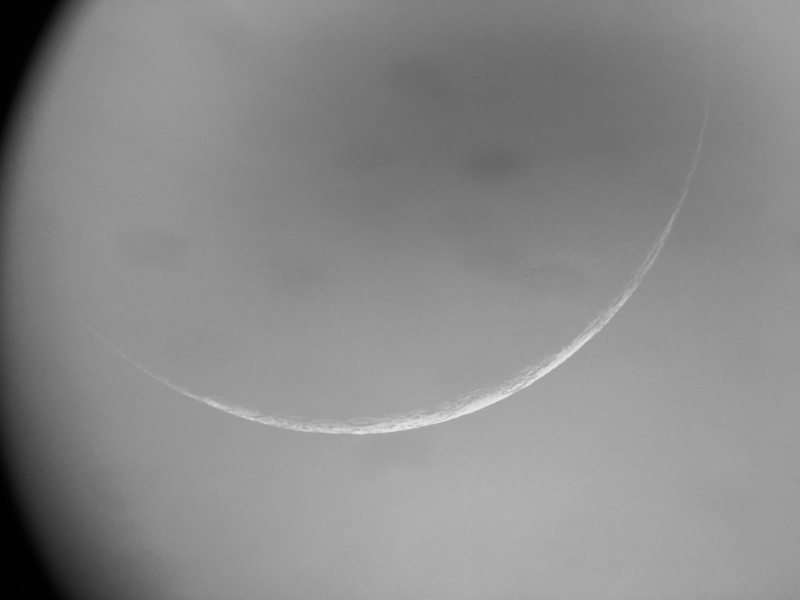
Next, used the D7200 DSLR with the Tamron 150-600mm lens (on a tripod) for this f/8, 1/100sec, ISO 400, FL 600mm, photo:
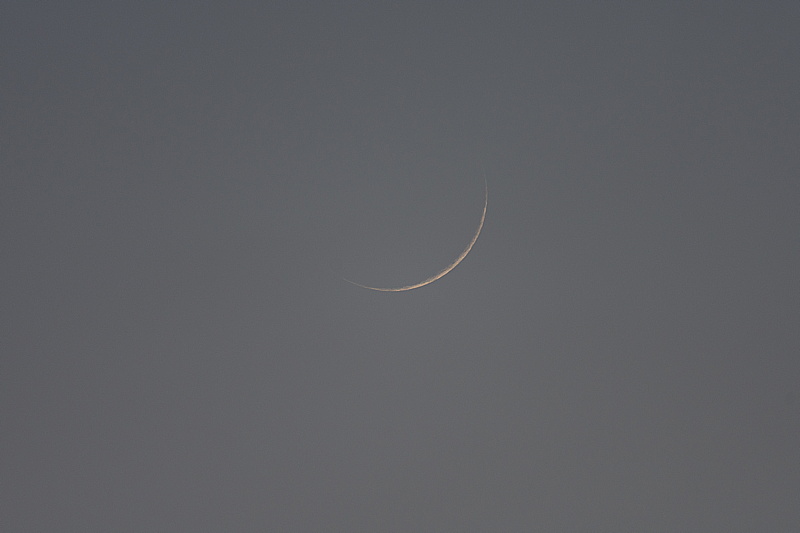
This photograph of the observatory (lower left), the western sky, and the crescent Moon (upper right) was taken using a Nikon 18-105mm lens (handheld), f/4.5, 1/30sec, ISO 400, FL 42mm:
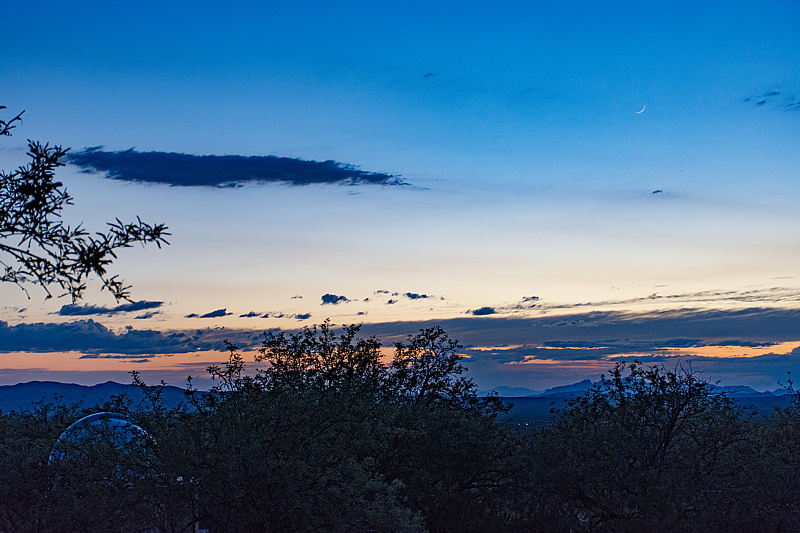
As the Moon was getting lower and into the trees near the observatory I took this handheld iPhone photo (slightly cropped), afocal 102X:
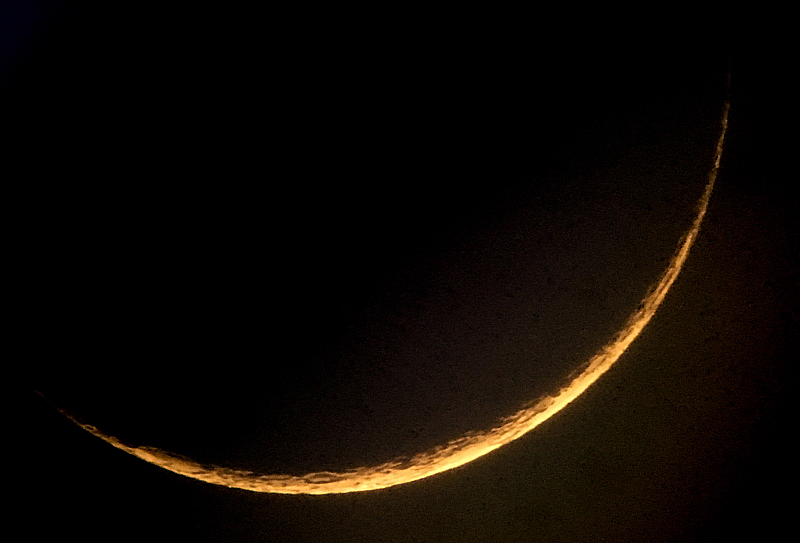
1938 MST: took a quick look at Jupiter, 102X. Three moons were visible.
Next, slewed the telescope to the star Arcturus for some DSLR focusing tests with the camera at prime focus + visual back. I wanted to compare focusing with just the DSLR "live view" vs using the Astrozap focus mask. As expected, using the mask produced a sharper focus.
Once the focusing tests were completed, slewed to M64 (Black Eye Galaxy) to do some StarLock autoguiding tests. Since the telescope is now permanently mounted on its pier, I need to learn more about using the StarLock for autoguiding, and that means learning how to best adjust its settings. This session I would do 2 minute exposures with the StarLock guide rate percentages (both Right Ascension and Declination) manually set to various rates.
2010 MST: moved the dome onto the PZT. 2020 MST: the sky was now mostly clear. The Zodiacal Light was visible in the western sky. Then had to swap the Wireless AutoStar II batteries.
2035 MST: began doing the guiding test exposures of M64. First did an unguided (StarLock OFF) exposure, which, not surprisingly, trailed. Next, turned the StarLock ON and did several 2 minute exposures using guide rates of 5%, 10%, 15%, 25%, and 33%. Some autoguiding errors were seen at all rates. I also tried 5 minute exposures using guiding rates of 5% and 33%; both trailed. Not certain what I learned from these tests. Need to do more testing.
This is the best 2 minute, ISO 6400, White Balance 4000K, guide rate 5%, image, slightly cropped:
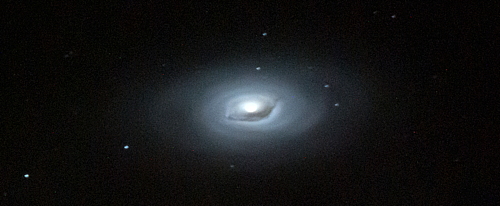
2130 MST: clouds were now visible in the southwest. I tried imaging M87 and the Omega Cluster but was not happy with the results. 2140 MST: the clouds were now rapidly getting higher in the sky. 2148 MST: ended imaging.
Took a quick look at the Omega Cluster (globular cluster), 102X. Then viewed Mars, low in the southeast, 102X. Seeing was not good and no details were visible on the planet. The sky was becoming mostly cloudy so began closing up.
|
Close: Saturday, 7 May 2016, 2215 MST Temperature: 55°F |
Session Length: 3h 38m Conditions: Mostly cloudy |
Comments are welcome using Email. Twitter users can use the button below to tweet this report to your followers. Thanks.
Cassiopeia Observatory Home Page
Copyright ©2016 Michael L. Weasner / mweasner@me.com
URL = http://www.weasner.com/co/Reports/2016/05/08/index.html
